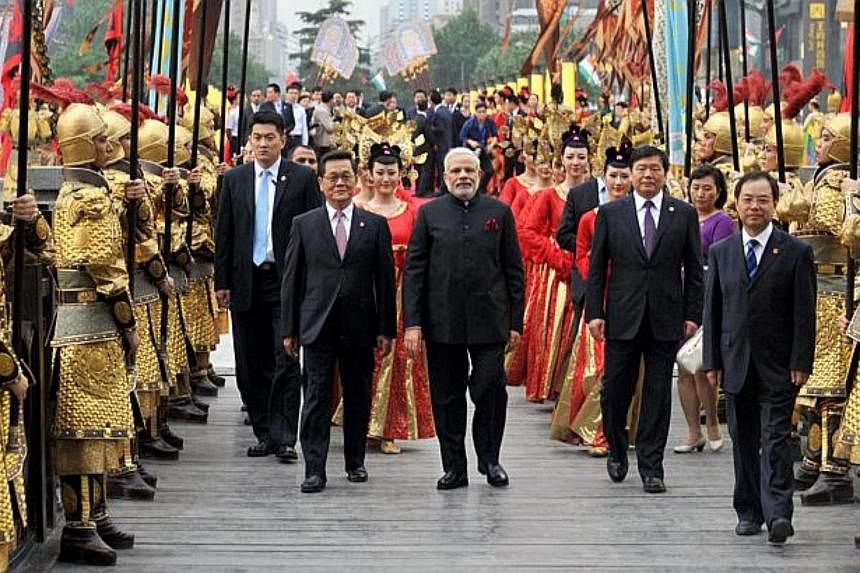Between 1024 AD and 1665 AD the ancient Hindu temple of Somnath in Gujarat, Indian Prime Minister Narendra Modi's home state, was attacked and ransacked no fewer than five times by marauding chieftains, starting with Mahmud of Ghazni and ending with the Mughal emperor Aurangzeb.
Every time, it was rebuilt and restocked with ornaments and precious metal. But little was done to ensure its protection from the next raid. Such was the barrenness of Indian strategic thinking and the nation's abiding faith in the gods.
That sense of fatalism and complacency continued into the late 1950s, when the newly independent nation's ties with China began to fray, leading to a crushing military defeat in the 1962 war over their Himalayan border. The shock led to a rapid re-arming of India, complete with a nuclear programme, that has pushed it into the ranks of Asia's big powers, giving it an increasing capacity to project power beyond its immediate neighbourhood.
Even so, India was content to remain a reactive power, keener to be loved than feared.
As recently as a decade ago, when a devastating tsunami wrecked many installations in its Andaman & Nicobar Island chain, the government, ignoring suggestions from its military, avoided using the rebuilding opportunity to beef up defence installations along the strategic island chain. It figured that doing so would cause concern in South-east Asia and spark a response from China, always nervous about the Malacca Straits being a choke point.
Things are changing though and two recent events highlight how rapidly India is turning into a proactive power. The Look East policy of old has turned into an Act East policy and Mr Modi is making good on his word.
The devastating April earthquake in landlocked Nepal, and the promptness with which India responded with its army and air force, showcased the trigger reflexes of the Modi government and the capabilities it could bring to bear in an emergency.
And, from a strategic point of view, last week's inking of a "vision document" by the Indian and Vietnamese defence ministers - a paper that both have chosen to keep secret - underscores how far afield India now sees its sphere of influence, never mind whose backyard it may enter in the process. New Delhi is also swiftly building strategic ties with the Philippines, which is locked in a maritime dispute with China.
On May 18 an Indian defence ministry release noted that four ships of its Eastern Fleet - including a guided missile stealth frigate and its latest anti-submarine warfare corvette - were on "operational deployment to South Indian Ocean and South China Sea".
Meanwhile, a confluence of circumstances, led by worries over China's increasingly assertive external posture, has placed India in a strategic sweet spot, at ease with and courted by a host of powers, including the US, Japan and Russia. This year, India will send its two aircraft carriers and other modern ships to join frontline ships from the US Pacific Command in their biggest joint exercise. Japan also will join the annual wargames, called Exercise Malabar. Increasingly, the term being used by military men and strategists is "an Indo-Asia-Pacific region".
Meanwhile, the India-Japan strategic partnership is growing apace. India is likely to be the first nation to receive the ShinMaywa US-2 specialised seaplane as Japan takes its first tentative steps in the arms export trade.
The US-2 will be a force multiplier for India because it would be able to quickly inject troops into areas where there are no landing strips on shore.
"An Indo-Pacific definition of Asia lends further legitimacy to India's growing role as a strategic actor in East Asia," the International Institute for Strategic Studies said in its latest Asia-Pacific Regional Security Assessment. "It also offers an intellectual rationale for a stronger US-India relationship."
In January, US President Barack Obama paid an unprecedented second visit to New Delhi, this time as chief guest at the nation's Republic Day celebrations. The summit's notable outcome was a US-India joint strategic vision statement that spoke of partnering on issues stretching from Africa to East Asia.
Most significantly, it affirmed "the importance of safeguarding maritime security and ensuring freedom of navigation and overflight throughout the region, especially in the South China Sea".
Such a bold tilt to America would have been unthinkable a decade ago in India.
"Modi's foreign policy is geared to move India from its long-held non-alignment to a contemporary, globalised practicality," says strategic affairs expert Brahma Chellaney. "A multi-aligned India also will not shy away from building strategic partnerships with countries around China's periphery to counter its India-containment strategy."
Still, some of India's moves are aimed not so much at checkmating China as pressuring it to drop its assertiveness on the troubled border and lie low in India's backyard.
India and Bhutan are the only two nations with which China has outstanding land boundary disputes, Beijing having settled with a dozen other nations on fairly generous terms. Eighteen rounds of border talks between Special Representatives of China and India yielded only limited results.
Earlier this month, paying a return visit to China, Mr Modi, unusually for an Indian leader, publicly confronted the Chinese leadership on the issues that divide them, even as he stroked them on a variety of other fronts.
"We covered all issues, including those that trouble smooth development of our relations," Mr Modi said in his statement.
"I stressed the need for China to reconsider its approach on some of the issues that hold us back from realising the full potential of our partnership. I suggested that China should take a strategic and long-term view of our relations."
At the same time, India has halved the size of a new mountain strike corps specially raised for the China border - a friendly gesture. Likewise, not wanting to show his hand, Mr Modi declined an invitation to address this year's Shangri-La Dialogue, instead sending the junior defence minister.
It is too early to say how China and the wider region will react to India's mixed messaging. But clearly, after a long period of inertia, there are active minds at work in New Delhi and the fruit of their toils is only just coming into view.


